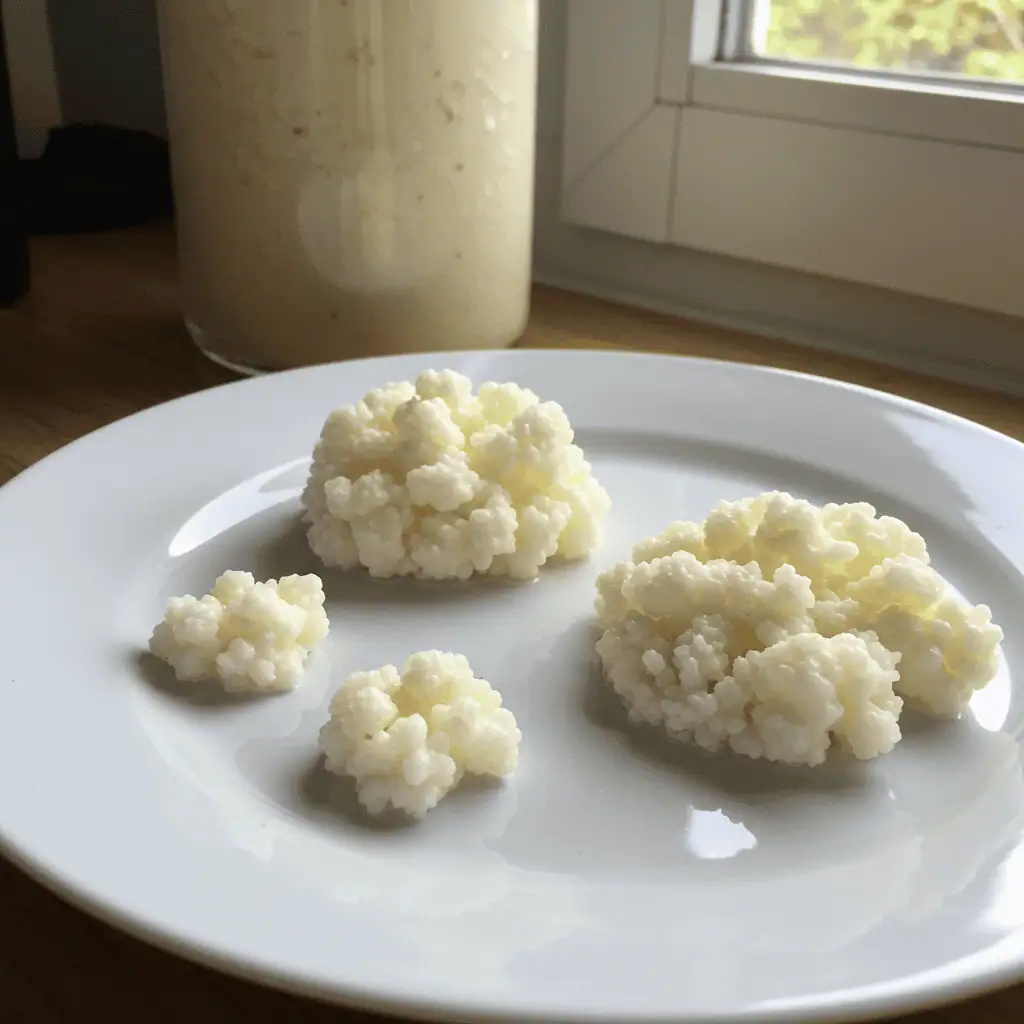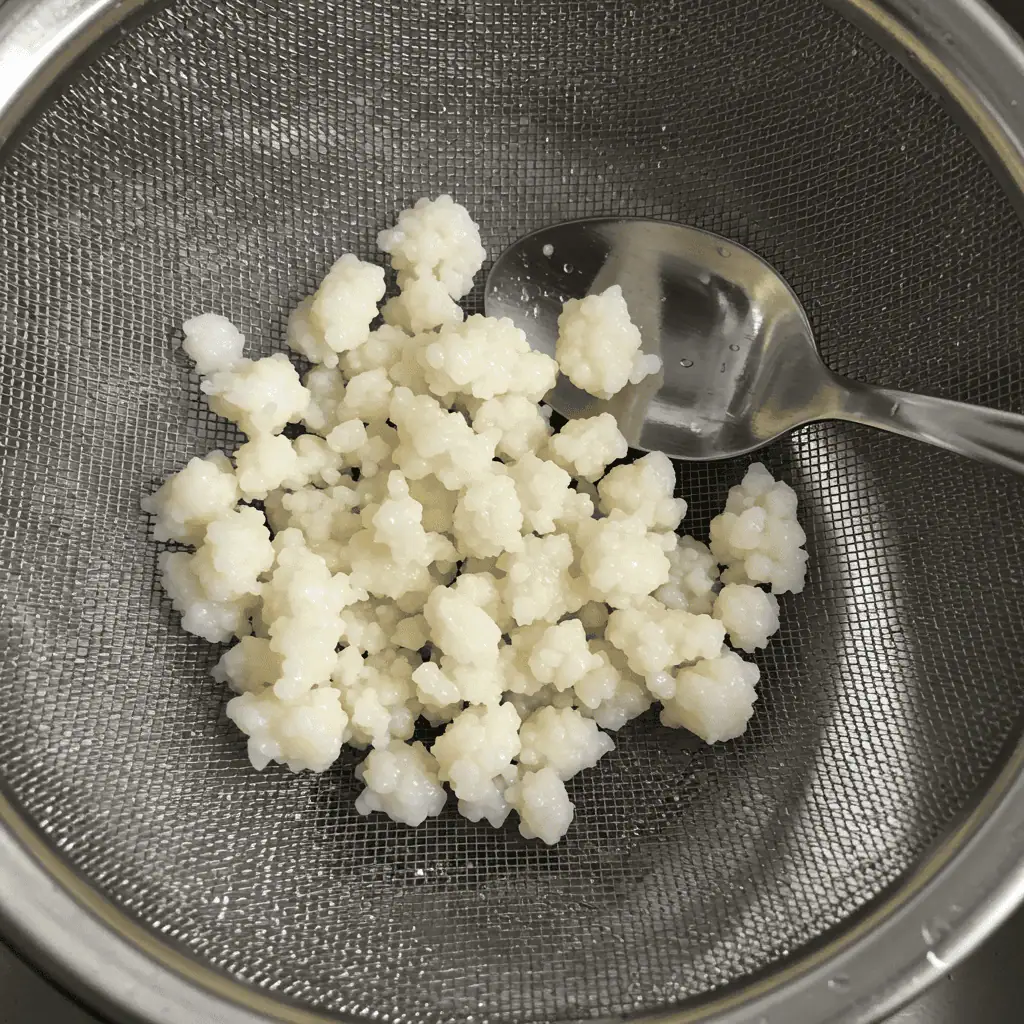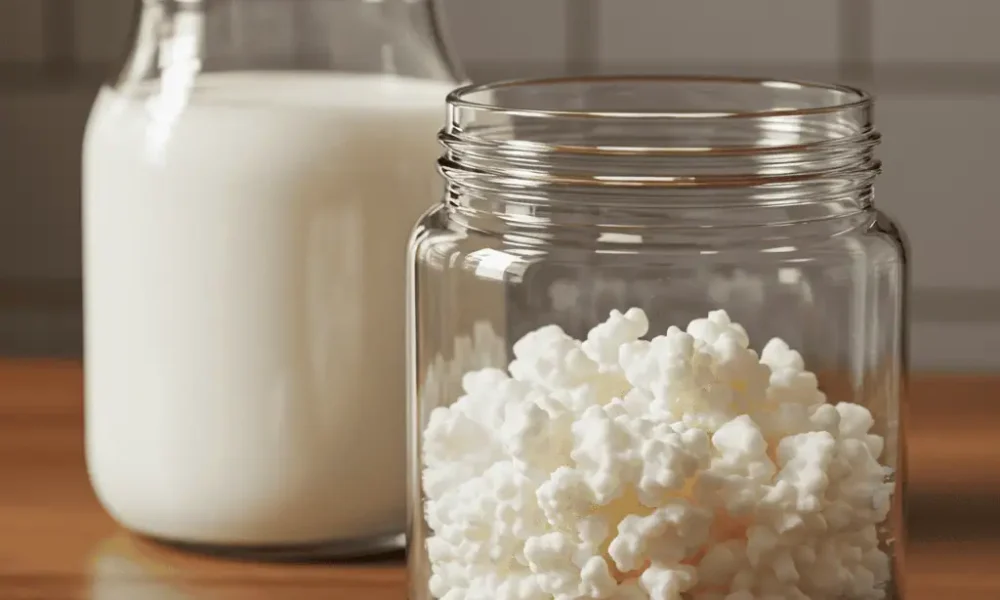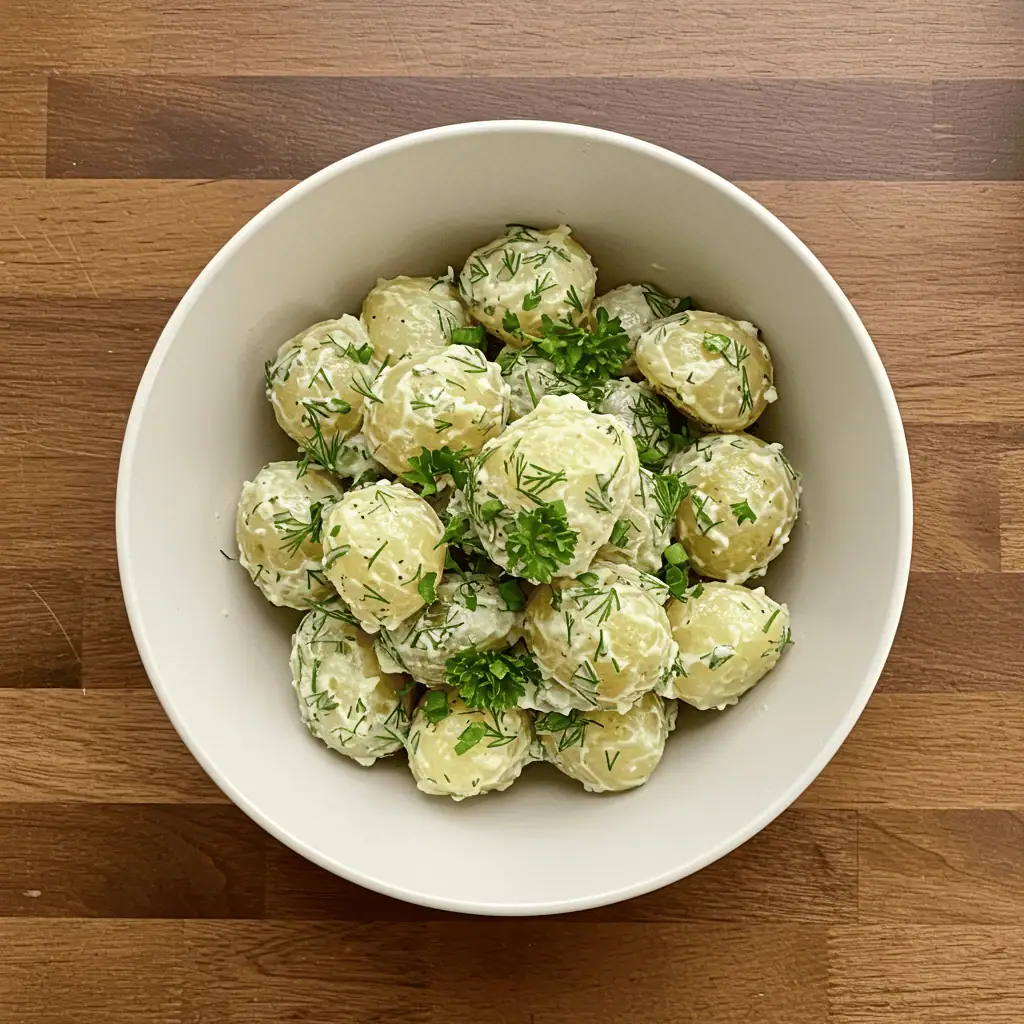Fermented foods like kefir are getting a lot of attention in health circles, and for good reason: this drink full of probiotics is great for your stomach, energy, and even your complexion. But when you first start using kefir, you will always wonder how long it takes for the grains to grow.
This detailed tutorial will show you the whole kefir growth cycle and give you tried-and-true advice on how to make your grains grow quicker. You’ll learn about the things that affect their growth, common problems that can come up (such grains that are too little or not growing), and how to get the most out of them in terms of size and number. We’ll even answer queries like why your grains aren’t doubling or how to help them grow faster.
Looking for inspiration? Try this gut-friendly meal idea using fermented dairy sheet pan eggs with cottage cheese as you dive into this comprehensive kefir grain guide.
Understanding Kefir Grains and Their Growth Process
What Are Kefir Grains?
Polysaccharides hold together colonies of good bacteria and yeast called kefir grains. Even though they are called grains, they are not real grains like rice or wheat. They are more like little blobs of cauliflower with a jelly-like texture. These grains ferment milk over time, turning it into kefir, a sour drink full of probiotics.
Lactic acid bacteria (LAB), acetic acid bacteria (AAB), and yeasts all live in each grain. If you take care of them properly, this live symbiosis lets kefir grains eat, thrive, and multiply. Kefir grains may live and reproduce forever if you give them fresh milk on a regular basis.
The Science Behind Kefir Grain Growth
Fermentation is what makes kefir grains grow. Kefir grains eat lactose (milk sugar) when you put them in milk. This lactose is broken down into lactic acid, ethanol, and CO2 during fermentation, and the structure of the microbes grows at the same time.
Several factors influence the rate of this microbial expansion, including:
- Nutrient availability from milk
- Room temperature
- Acidity levels (pH)
- Grain-to-milk ratio
- Exposure to air and light
The process may sound scientific, but it’s easy to manage at home. In ideal conditions, you’ll begin to notice visible grain growth within 5 to 7 days, with more pronounced multiplication over the next few weeks. By understanding this process, you’ll be better equipped to foster faster, healthier grain growth.
Discover great ideas like high-protein overnight oats to pair with your homemade kefir for a balanced probiotic breakfast.
Growth Timeline – How Long Does It Take for Kefir Grains to Grow?

Initial Growth: What to Expect in the First Week
When you first receive or activate kefir grains, don’t expect explosive growth right away. The first 5 to 7 days are primarily about acclimation. Grains need time to adjust to their new environment—whether it’s pasteurized milk, raw milk, or plant-based milk. During this stage:
- You may notice slight swelling or softening.
- There will be light fermentation and a mild sour taste.
- The grains may begin producing small bubbles due to CO2.
At this point, growth is slow but foundational. They’re not multiplying yet, but they’re preparing for future growth.
Long-Term Multiplication: What Happens After 3 to 4 Weeks?
If you continue feeding your grains daily with fresh milk and keep them in the right conditions, most active grains will start multiplying noticeably by week 3 or 4.
Grains can double every 7 to 14 days under ideal conditions. You’ll likely see:
- A slight increase in grain size.
- More clusters forming.
- A thicker milk texture after fermentation.
By week 4, a healthy batch of grains could increase in mass by 50% to 100%, depending on factors like milk quality and room temperature.
Don’t miss our guide on healthy pasta salad with tuna, another gut-pleasing meal you can enjoy alongside your kefir journey.
Factors That Affect Kefir Grain Growth Rate
Temperature and Environment
Temperature is one of the most critical factors in how quickly kefir grains grow. The ideal temperature range is 68°F to 78°F (20°C to 25°C). Growth slows dramatically in colder climates and may cause inactivity or shrinkage.
Other environmental considerations include:
- Avoiding direct sunlight.
- Keeping grains in glass jars (not metal).
- Using breathable cloth covers to prevent contamination.
Room temperature that’s too cold? Try placing the jar near a warm appliance or wrapping it in a towel.
Milk Quality and Type
The type of milk you use makes a major difference. Grains thrive best in full-fat, animal-based milk, especially cow or goat milk. Plant-based milks don’t offer enough nutrients unless specifically fortified.
Here’s a comparison table:
| Milk Type | Growth Support | Notes |
|---|---|---|
| Whole cow milk | ★★★★★ | Best for regular feeding and growth |
| Raw goat milk | ★★★★☆ | Slightly faster fermentation |
| Low-fat milk | ★★★☆☆ | Slower growth, fewer nutrients |
| Plant-based (almond, oat) | ★★☆☆☆ | Need calcium/protein fortification |
Learn more about building healthy, protein-rich breakfasts in our healthy breakfast sausage recipes post
How to Encourage Kefir Grain Growth Naturally

Best Practices for Healthy Grain Multiplication
To encourage kefir grains to grow fast and strong, apply these habits:
- Feed daily with fresh milk.
- Maintain a consistent 70°F–75°F environment.
- Stir the milk once or twice during fermentation.
- Use the right milk-to-grain ratio (2 tsp grains per 2 cups milk).
Rotating between whole cow and goat milk every few days can also offer diverse nutrients, boosting microbiota balance.
Mistakes to Avoid That Can Stunt Growth
Even small missteps can slow growth significantly:
- Using metal utensils (kills good bacteria).
- Refrigerating grains for long periods.
- Leaving grains in over-fermented milk for 48+ hours.
- Feeding with ultra-pasteurized or lactose-free milk.
If your grains seem sluggish, try a rest cycle: place them in fresh milk in the fridge for 2–3 days to recover.
How Long Does It Take for Kefir Grains to Double in Size?
Typical Timeframe for Doubling Kefir Grains
Under ideal care, grains can double in size within 7 to 14 days. However, this varies based on their starting health. You’ll know they’re doubling when:
- Volume visibly increases.
- They ferment milk faster (less than 12 hours).
- The grains look puffier and more clustered.
Doubling may take longer in colder climates or with lower-quality milk.
Boosting Size and Quantity the Right Way
To speed up doubling:
- Switch to raw, organic milk for a few batches.
- Strain grains gently to avoid damaging them.
- Add a pinch of prebiotic fiber (like inulin) to the milk once a week.
Looking for inspiration? Try this protein-rich recipe featuring fermented dairy cottage cheese egg bites to pair with your kefir.
Why Are My Kefir Grains So Tiny?

Common Causes of Shrinking Grains
Shrinking kefir grains often point to stress or poor feeding conditions. Possible causes:
- Low nutrient supply (milk too diluted or skimmed).
- Acid build-up from over-fermentation.
- Infrequent feeding or refrigeration.
Smaller grains can also indicate:
- Excessive straining.
- Poor milk absorption.
- Weak microbial balance.
Solutions to Help Regrow Smaller Kefir Grains
Here’s how to rebuild their strength:
- Use whole milk with high fat.
- Rest the grains in cold milk for 48 hours.
- Reintroduce sunlight indirectly (not direct exposure).
- Consider a “booster ferment” with cream for 1 batch.
Monitoring and Measuring Kefir Grain Growth
Tools and Signs to Track Growth Accurately
Use these tools to monitor grain growth:
- Digital scale (track weight weekly)
- Volume-based tracking (teaspoons or tablespoons)
- Growth journal (record dates, smells, textures)
Growth signs include:
- Milk thickens within 12 hours.
- Grains appear larger or more jelly-like.
- Increase in tartness or fizz in the kefir.
How to Know When Your Grains Are Fully Mature
Mature kefir grains:
- Are creamy white and squishy.
- Have cauliflower-like shapes.
- Ferment milk efficiently (within 24 hrs).
Once mature, you can begin separating portions to start new batches or store for later.
Storing and Using Extra Kefir Grains
How to Store Surplus Kefir Grains
Surplus grains can be stored short- or long-term:
- Short-term: Store in fresh milk in the fridge (up to 3 weeks).
- Long-term: Dry the grains and freeze them in airtight bags.
Add a note with the date to avoid confusion later.
Creative Uses for Extra Kefir Grains
Aside from making more kefir, you can:
- Blend into smoothies.
- Feed to pets (dogs love them).
- Use in sourdough or pancake batters.
- Blend into face masks for probiotic skincare.
Check out our favorite wellness bowls like this quinoa chickpea rainbow bowl for more inspiration.
FAQs About Kefir Grain Growth
How to encourage kefir grain growth?
Keep the temperature between 70–75°F, use whole milk, and feed grains daily. Avoid over-fermenting and switch milk types occasionally.
How long do kefir grains take to multiply?
Healthy kefir grains begin to multiply within 7 to 14 days, and can double in size every two weeks under ideal conditions.
Why are my kefir grains so tiny?
Tiny grains are often a result of poor milk quality, refrigeration, or over-fermentation. Restore them with raw milk or light feeding cycles.
How long does it take for kefir grains to double in size?
With consistent care, kefir grains can double their mass in 1 to 2 weeks, though some environments may slow this growth.
Conclusion
So, how long does it take for kefir grains to grow? The answer depends on the care you provide. Most grains begin their growth journey in a week and double within a couple of weeks when nurtured properly. By optimizing their environment, milk source, and feeding routine, you’ll have a thriving batch of probiotic-rich kefir in no time.
Learn more about maximizing fermented food benefits in our cottage cheese and eggs guide.











